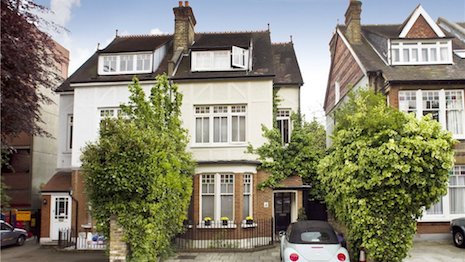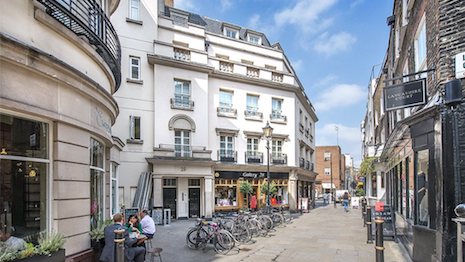While the volume of residential sales in London's most appealing neighborhoods climbed this August, prices of homes in outer London declined during the month.
In the central London neighborhoods of Kensington, Chelsea and Westminster, the combined number of sales above 2 million pounds, or $2.5 million at current exchange, climbed 9 percent in the year to April 2018 compared to the previous 12 months. Outer London, however, saw a decline of 2.6 percent in the average prices of homes between 4 and 5 million pounds, or $5.1 to $6.4 million.
London real estate
The London real estate market continues to be one with mixed signals.
This July, the number of new prospective luxury buyers in London compared to the number of listings jumped to the highest ratio in the previous 18 months. If demand continues to outpace supply, prices could rise in response.

The Kensington neighborhood in prime central London. Image credit: Knight Frank
While central London has seen an annual decline in capital value of 2.3 percent, outer London's annual decline was steeper at 4.1 percent. However, a more narrow look sees a decline of less than 1 percent in both central and outer London.
Since the pound remains weaker than the U.S. dollar, American buyers would currently save by investing in London real estate. The London market may also benefit as stock markets in other economies, such as Turkey, have continued to fluctuate.

Outer London, including Wimbledon, has seen steeper declines year-over-year. Image credit: Knight Frank
The Mayfair neighborhood is the strongest market for tenants in central London, with an annual rental value growth of 5 percent. In outer London, the number of renters has reached a three-year high.
Tenants are also staying put longer, as the average lease has climbed to 16 months over the last two years.
Western European real estate
Similar to other major Western cities in recent years, London has seen an increase in Chinese and Hong Kong real estate investments. Following the original vote for Brexit, the pound’s value went down, offering an opportunity for investors to purchase properties at a lower price than normal.
However, in 2018, there has been a downturn in Chinese and Hong Kong investment in London. The money invested has not been this low since 2015, prior to the Brexit vote (see story).
Additional research from Knight Frank found that urban luxury residential markets grew just 2.6 percent in the year to June 2018, the weakest annual growth rate since the fourth quarter of 2012.
Knight Frank’s Prime Global Cities Index for Q2 2018 attributes the weaker growth to several top markets increasing at a slower rate, as opposed to cities declining. Most of the faster-growing cities were in Asia, while Western European markets saw slower growth or even declines (see story).
{"ct":"yJkXd9O+ZxeQO8bZ0TVwK7CrGodRDm5toSSKaPhYmeOE0jH7fYZ6PZs8opV2eB2j71zAFSfvMVpsiR3kBoIS+P5dp+PCtFu69POaUx0mCe8qj0gGbEWmzAi2ZHeVdmbMst74CFQ9EiCT1YLP3KcztudhDHnltLM42boNNlXzNalAZjMl2b5qZWEzGd7l1tcoOaY1JvbuUCJi3ERa8\/opjIaUWp99NcgP5eB5b4tk99S+GI\/rYbknqxSTkvFyRXhNIK1Sh2KP3wdRwdRiO5DN8uw3DFkgnJZ\/5JkhHVzFHdkvQiNWzRjKTnE6XOToh37eH502Cod5fD3lEKSviSEDJ84GUAfvSDn+Ft05pLKzL3U71ktl+vy2ahogLo4gXjwrApRYA+7keYj6qo5Ir\/kHSMOU4uL57fD0abkoLAmnTR0bYA1DOLnpbp5PDAi7mjkDCcRQrMLVAhZTScwvskJoRRJbFGYCpQ+l+H+CpNjirzwDnDEJAdJHwg1Wnm2q07vrz\/4yRfStkphRX1f\/o5T\/HWGuab9ujBbOQmR0wGZ6Fnewu3txnjkQumnU0mj96HVAmIGa5yA2vzFn0UBddqvvEqTdP3vyWge9aqYbBwo3BbHyo4Q5DxRiT9i+K7K4v7W7ytd7TZGr\/q46AuFueHgHD\/6kVcrxre9K6wXLyEtYBj+6iYvf6pN8pXY2ImORw5fa0jDfO+uiVQ\/5kwDfiq0PEjvPISbf2XFjzKNnhkz9nn6lme7qs+WDqiWCQ1\/7UEEvZ\/xSLr7\/It2NmczGOiT\/oV8CWPkCI2nUD5WmDNVFPpx+gPFqaBh22vpvErE0332e63QrXA6xeAKGnXVbUoxOxIz1Lon2RJvk6dbKhdHklHGBpUOxNFJI2+YT3Cyq7ECJB7zvGG9vpfvcItRIIxfLAuF7fIHj9yrzMDuzh7PIGN8X3QpD8RvvMnpyTgpodmcqmtEz6wPrO\/a7pwSaFwJFKaFc\/iIHKroobg8w2Z94YAreoLgUREKnhu0fC8zExDXodpvsPmEDCaioRMHy0ziN\/1GqDW\/yUj3GTWfUYJPGFQTY3d9VyP1SCM81awWEBhwpC859CyE0y2kO28kRMSkkK+GXA40+0t3XqlLckqnGXZzY3Kq0fzNXF9hzv\/N7kB01+m6HcriLQz0Fio9mhPu6Hf14eJ1EbmuRB4nFNssgKamQswgoKN+ZN3Zo5aRDpQS07aKY2r2kuZj1DUshCQysduyB40Igs1DPij7fgApT5rFZu4gFWk0QO5tvNhp5Jl3\/3XucB5R11UHIt+OlG5vIqWlq6ZS7hI0Q\/2EVueAWIKVOOLYvxQ+A3mrE08WpBAPFVieb9nn0LYNyUTTVZEPYdhyh7EUILcUrRUMy2zKfV9BCjyEUC\/B7nDiEubnBJ4p9fzPt8wkfBProSCZnXaiHx2CYkREmH6cdsuLoMPYkfi3cGSKTS7GtkLdl0pzAvqV8MRCy3bJ8j84J+mfURWt6WU+BMlr0CmV3pW7EFF0sYFCqGaI76pRz2IKLQYwpDTJ5rjXpEmpKNVsrGtHgLtjT85owK2160ywhKO4EzeAdnyEj3j5YqgYn7PZY04efzg8n\/KFTApLfc9\/arqC2YwbE9aFlOAi5QhTYLeHnchOUzOdvHK0eBbT2k57g1ADROD6ohVLKj6VweOgOPTMPLU0qCfBqDZOHk35TPRfVdXI6Gk+s3s2tctBr1kg\/AYx5L7nCNowUTxA8Ngpx0XA9H8WLtvjhoGnDlPQsUAUzqNm3NnYtMTb78BwQfCH4wGn0kePSKJPwprX37lZYbXL8RhV7ezF0SpR0xP3LAieHudmWK5ceHCr4E28nwhrI194r5BT8+VTF0bdkTWD9bQep0QwvfKv5v\/MxA1A07eHzy3rUQOOFocCjBIpcLAbVU9Do5nDUyfqBqm+GSQUxNj7Zwk5A0P6R3zp5K18dw6nq34CRaBYqKDHXeDCWlgeds\/\/a6CRb1+6uI6N4pzvVY7vALQgWz3k6vUtk6uzx1zv\/HZUDfcKLKj+qTluuVCnDxBT7oYzguwXjTxlY4BmskVHjM0lU3XsFVAkkQO6E4WdX5J+XzL0YlWD0iAE15q8LBUlJoYWiR+5+zAuiBDiuVRwBowqpFWIqRBUY7OwDhfqmmCQL8GQ8mMVrZlWtksQbr8ql2XfAnaZECFH8pTUgkZS9aukH+ENzKYBp03dVQrOBWsKsrbK43qfbOVBNgfTi17tJdIBrYA\/aA\/yjVhLj0xCjGh+aLh6rALWgBB2MZTaoJFXaGLwZpsqpgh6Aesyf1Wqp8MAtgNrfLa2PZCc38Po9dWgVKlV\/3YME4IlX17wzu9cSLFDor9+q9vyjiJ83TR\/pYwU0jxnbMHw9H6VaWOq7chveBLFKDhGzol5KeC6dpBlD7rR7y95Pr7\/iNGIMtAIwf1f7Q3QNi6ZE0u3Cgx9Jeg\/w5kcpQJcqNV0f5yy1p3PLdg9VZvmcgWUZvqSHmacekxwhHVsUtOS\/rdJ6wHTS+1xoapjDaR9+Eg3KaCsqgiHKL657YFfF9YEKBj4\/f96Wwi69Dvayu3DVEZte8rMnx2xHEpucv1twDJZU0wZ49Sj6oYQ2Jzs940djR\/plKy9ivVlvxJZvhnR13bylH6kxf0737PSourSFIFtlPpnphEVLP\/zKY9hBKPl5SI8eNModVAE8SjQLJAyPH4d1TawoLNHDTZx2IyOWu5DJKFXyxX7El+b5y6Jfu5eNRuW\/vm16Z+P7y8TuyWb4z38UJJb6AEuhL31lgGZ+W+QA1AbOU7pmxGdb8E5izN3ISAlMi7PqhA\/BZZcExR0NxKGlqECPVN+OcoAi1WmYDfCNChcY5Pk7EtjjvriW9XYYcOp73jzQXKvAzdd1K8vwMYBH4XMa4YDw8\/M8OD0TdR4j+IjK4gdWomRxqSMtkwgoQJCCI7B8eMOHY1H6BzV5Vhi1WzhzdruneygnwGkXKS4isrxqMWogOy\/76VpKjhbIfctJmmbR5bEkg3f87kePYqri+fY5bR0gsu973X3h91cms\/tZvlYy66ijORuXZ5b0C31k\/mb6GyEJJZK3RNQq6JOkMG6VHoQX3pbJBoJ4ZFdWEB0fmKOFVeudNcFsUqv9rCviJBYstm2MxF3RoPw4pOtBImygkPPiUtT2PamAXlh6m1tckfwiS8+Pf\/FpmwUxdkmtt6AwbiO9phQ+eu642y6mNVuHFQdApXhUsKFKeQtED9Ode2lltEcITLM1NRNXFElRNGkbY2aaBKlNI7hyn+6gI6iILhRdQBgzY2C1tXCUzx1PTsS7ygEV262ZrHix4h4zZawUytnORNfQiU+\/8VjkGGGUWt89lb8UUZEmLXHkCGZn+7j4SuEjxXDW3qgclJuuEc21B5A84S3aJwmStTjMfwUEXy4VPTMdTXHvDymGC66JKkSoNXaktyr4YdHUelS3CJXy6jc6g3ss2Oc\/dj6gydx3uXldiVj\/ui6OPzhD7WYgy1mW3AnTerVpgTOER6ygChbFRX1+hnWI\/DewKfx8eSV2zGhQCO0A1ytGzB3F+qM2\/sYqW3hh2JAdnRmNVeD3t09w2sPMBKm0u6NQtJNI61euPejkZB1KRRoDrOk0QVTqtN+QG6ZRMPDq1Ts317ZgJsKL3FqixqYYikczJRev4CC9kVXoAbPdNPkGzlKQKPx35Atj0jn5baHsUC2ctwz0qtCvXLanAVQy6MDQANJIZrFsTY7v\/QaQxU5ThyV5GfoISKEyIEQXGyBBC9zX+Xvw09vzOADvf+VGXB8EYkDdSmvLnzC9rub\/q3acY+X45Iz1pCwqF+6UKmhiHm7M0lGjEF34ec5A7+9FWu+yQz\/Sfilm2mw5LB7uWrY4fJ8mrJZ8VP9Hpi9ohU1u5+rdJHATShvASzjbDXf8HelUZmepRviCwd\/dZa1u3H7CDCEiEsGQAputntNn4\/E1t98aogWV+N52EdznbE90s59x99s2c6U4MPfRLsEgdDTlVCjPwh\/g6sYVtJHvUQQcZC7tbRntIQXXAMr3AHZHHEuRZGndC3+WifEB8W5p3l+wNlbYt34WDC93bywbky55+SeXzOo9YTmDM0mmN8mzOReZzRk+TbhgNJ2bw\/6xWGgtoHJpgUC+BBI7JuPBiwyhTIBTe2zzzfW5aemkPFnIx5j3sN2svjMXP1nSka+i3ji+hrh4yj6tNxkwGdYWXbWhlGTTql\/0aB8RrLdsKwEBKLQCSFeW0vcx8K\/si8txsI85ENQvxfsEDbZXvaEStzfqXhh4MMxBTFqzVhFem\/AU99WJ4MLAOEWyPODfY8qe1I3RN0TUNibr5jFlGgO18+vOBwFyl61LndygNLTK6g\/sE4mJud0YIWo7ZirE9xjNO9zOWxjG81mRyItHVSczT2TsI\/NiGXt1T\/JU5ppyjbMuDrWs2tK3AoEd+MGEIoCZPaje1r4afWhlYRbpGAmp\/yoMuguTB4UGtesTOSP9ja7R90WGnAsknWnMself32\/Udfq6mzjzBBmKZj+xNm6gZfkpBWj5I6RpTyoJ6zs5OP3SyIDjCzgt7KeX\/1mLnwOmQbLyU\/pa7dDfgBV+1CilSDl1vYAogzvckbA1+BbVHJxjgoPx8atpVxAWYW9\/9kFcexNpaTcB4EbxD9FSRwDlA3Ua2s1KukQ5F1PAY99\/nHo1XbDfa+cn5Q1rUlu0xmYmmFMmoI0XiAd1\/rgqPmujiDAdsnZ8QH608Nhdv6ZsasnIQZXzd+PG\/u5GQrUcMVZoSEmp18A94DfniaJsb2hgNzTgi+kRgCARiyyzvdeuwosAhwVxv6zzlv2Gqw2Nwhsa3ckJFsE0G3Io0UJe+ciRMoBbx5QFnj2wzUufbTAgEFia0xrXx14Ht3v5pBIMg6nuIlC7HrHCc3d9G2xEwTdRhTma\/BcyBS+VmOs2PlX4jGyp4EgRsCYjmptmabEThzjZhKnbzFe9G5JtwHTK860YZVlE86p3\/jA0EaOO6xGWvIgKawvayYDfLG2Dtg80wwkIY+rmxPXT8\/Yg+cQFILmyxd7pfIFYgxCUZBghN46nSc8b768PHK9YiIZdinGcZGadyOxVfEEjS5zbHMWjBFLhgCpdlYh7zY2uGr3nWWF8IiuFKLbD5Q38t78Kgx+84EgQ6M68CEjYlOOi9PL8eDnHKhYW9yvfdfxtuC4KqXbWttXHCJSG08jQ9eROVUWSgukCqnGSyziaJvmDMgAI6TaqBGzdOBAOdxGIgl3xnSK3Nnb20ljFx2WfomFLWCY1qS\/XvK0eTFyr1pnEh8WVJYSMnYsD0KqKcEj9s0TA96Xq8RNkyUDcoSxGDSp0wYU\/nZb8n8x6wpyvRivLb6CTQGTxrBQtsUvHDBOmL5DUTPekQZ+fIS4Ld8sUiO4Xv\/hjJ\/\/1dyT9+6Ha6g9xw0+jYtQa1uLlAjRNMlIhUxRfW\/rTMSRYJr2kbK02\/ydY+efD3gFIX2klJTsF7Ub5jIbfyWvQSpHCYRgpiq60hi521iLfIBnkwbGMn30jFb37fkLykA==","iv":"324a8ab82227effdfdd263dadc290f69","s":"5e238e4c94934116"}

 London's Mayfair neighborhood is in high demand. Image credit: Knight Frank
London's Mayfair neighborhood is in high demand. Image credit: Knight Frank